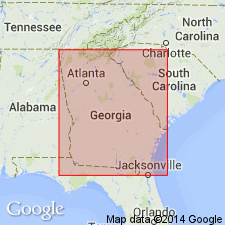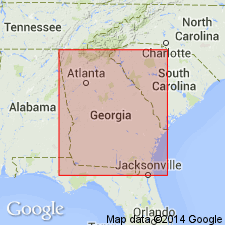
- Usage in publication:
-
- "Ringgold" Member
- Modifications:
-
- First used
- Dominant lithology:
-
- Siltstone
- Sandstone
- Shale
- AAPG geologic province:
-
- Appalachian basin
Summary:
Name Ringgold Member of Sequatchie Formation credited to Rindsberg (1983, Univ. of GA, MS thesis). Unit is red, green, and gray calcareous siltstone, sandstone, and shale. Environmental deposition interpreted as intertidal to supratidal. Underlies Shellmound Member and overlies Catheys Formation. Age is Late Ordovician (Maysvillian?).
Source: GNU records (USGS DDS-6; Reston GNULEX).

- Usage in publication:
-
- Ringgold Member
- Modifications:
-
- Overview
- AAPG geologic province:
-
- Appalachian basin
Summary:
At Ringgold Gap, the Ringgold Member of the Sequatchie Formation consists of 24 m of red dolomitic fine grained sandstone, siltstone and shale. These rocks are mainly unfossiliferous and contain a distinctive suite of sedimentary structures--graded beds, ripple marks, mud cracks, rip-ups, SKOLITHOS burrows--all of which indicate deposition in a tidal flat. On Rocky Face Mountain in Dalton, GA, the Ringgold is 35 m thick. The upper part of the unit contains interbeds of coarse-grained white to red sandstone, which increase in importance until they predominate in the upper part of the Sequatchie, and are designated the Dug Gap Member by Zeigler (1989).
Source: GNU records (USGS DDS-6; Reston GNULEX).
For more information, please contact Nancy Stamm, Geologic Names Committee Secretary.
Asterisk (*) indicates published by U.S. Geological Survey authors.
"No current usage" (†) implies that a name has been abandoned or has fallen into disuse. Former usage and, if known, replacement name given in parentheses ( ).
Slash (/) indicates name conflicts with nomenclatural guidelines (CSN, 1933; ACSN, 1961, 1970; NACSN, 1983, 2005, 2021). May be explained within brackets ([ ]).

